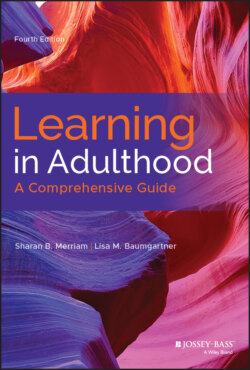Читать книгу Learning in Adulthood - Sharan B. Merriam - Страница 49
Motivational Orientations of Learners
ОглавлениеInterest in categorizing the various reasons given for participating in adult learning has spurred a line of inquiry in addition to the above survey studies. This area of investigation was initiated with the publication by Houle of The Inquiring Mind in 1961. Choosing a small, select sample of 22 adults “conspicuously engaged in various forms of continuing learning” (1961/1988, p. 13), Houle conducted in-depth interviews that explored his subjects' history of learning, factors that led them to be continuing learners, and their views of themselves as learners. An analysis of the interview data revealed three separate learning orientations held by the adults. The now-famous typology consists of goal-oriented learners, who use education as a means of achieving some other goal; activity-oriented learners, who participate for the sake of the activity itself and the social interaction; and learning-oriented participants, who seek knowledge for its own sake. For example, a person might take a French language class in preparation for a trip to France; or they might take the class to do something in their leisure time and to meet people with similar interests; or they may have always wanted to learn another language and so take the class for that reason alone.
Houle's research stimulated a number of studies attempting to affirm or refine the original typology. By far the most extensive work has been done with Boshier's 48-item Education Participation Scale (EPS), later refined to 42 items (Boshier, 1991). Factor analysis of the 42 items suggests the following seven factors, each containing six items: communication improvement of verbal and written skills; social contact, meaning meeting people and making friends; educational preparation, the remediation of past educational deficiencies; professional advancement, concerned with improving job status or moving to a better one; family togetherness, concerned with bridging generation gaps and improving relationships in families; social stimulation, meaning escaping boredom; and cognitive interest, seeking knowledge for its own sake (Boshier, 1991).
Boshier himself conducted an extensive test of Houle's typology using his EPS scale (Boshier & Collins, 1985). Using cluster analysis instead of factor analysis, because the technique is more congruent with Houle's original conceptualization of three separate but overlapping orientations, he analyzed the responses of 13,442 learners from Africa, Asia, New Zealand, Canada, and the United States. Boshier and Collins were able to effect a three-cluster solution “loosely isomorphic with Houle's topology” (p. 125). They found that “Cluster I consisted of the Cognitive Interest items and was congruent with his [Houle's] learning orientation.” Cluster II, the activity orientation, “was multifaceted and composed of items normally labeled Social Stimulation, Social Contact, External Expectations, and Community Service” (p. 125). Cluster III consisted of the Professional Advancement items and thus resembled Houle's goal orientation. The authors note that although their three-cluster solution is “loosely isomorphic,” the grouping of items to make up the activity cluster that matches Houle's typology is “overly generous.” They conclude that “Houle's intuition has been partly collaborated; two of the six clusters were as he described them” (p. 127).
Using Boshier's EPS, Fujita-Starck (1996) analyzed responses from 1,142 students in programs at a large state university. Results confirmed the seven-factor typology proposed by Boshier in 1991 (communication improvement, social contact, educational preparation, professional advancement, family togetherness, social stimulation, and cognitive interest). The author also found the scale to be reliable “in differentiating among a diverse group of students with varying reasons for participating in continuing education” (p. 38).
Despite the limitations of this line of research (Courtney, 1992), it has become evident that learners' motivations for participating in adult education are many, complex, and subject to change. The search for an underlying motivational structure related to participation is likely to continue, however, for such knowledge “can assist educators and administrators in identifying and meeting the needs of a wide spectrum of learners relative to program content, as well as the time, duration, and location of related activities” (Fujita-Starck, 1996, p. 39).
